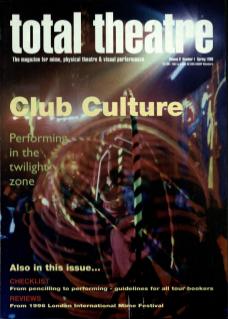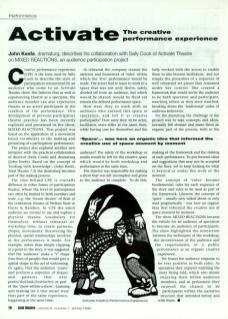Creative performance experience (CPE) is the term used by Sally Cook to describe the style of participation encountered by an audience who come to an Activate Theatre show. She believes that as well as experiencing theatre as a spectator, the audience member can also experience theatre as an active participant in the creation of the performance. This development of previous participatory theatre practice has been recently explored and presented in the show, Mixed Reactions. This project was based on the application of a movement-based vocabulary to the making and presenting of a participatory performance.
The project also explored another new initiative with the practical collaboration of director (Sally Cook) and dramaturg (John Keefe). Based on the concept of 'looking with knowledge', (John Keefe, Total Theatre 7.2) the dramaturg becomes part of the making process.
The idea behind CPE is crucially different to other forms of participatory theatre, where the level of participation can often be limited in both numbers and scale, e.g. the 'forum theatre' of Boal or the celebratory theatre of Welfare State or Horse & Bamboo. In CPE the whole audience are invited to use and explore a physical theatre vocabulary for themselves, without rehearsal or workshop time, to create patterns, shapes, movements, discovering the physical, spatial relationships involved as the performance is made. For example, rather than simply clapping at a point in the story, it was suggested that the 'audience' make a 'V' shape (two lines of people) that would give a spatial shape to the act of welcoming. Or again, that the audience 'create' and perform a sequence of shapes and patterns that were poetic/rhythmic/interactive as part of the 'show-within-a-show'. Learning and making (in a true sense) were thus part of the same experience, happening at the same time.
In rehearsal the company created the skeleton and framework of 'rules' within which the 'live' performance would be made. The actors had to learn to work in a space that was not only theirs, safely divided off from an audience, but which would be shared; would be fluid yet remain the defined performance space.
How were they to work with an audience who entered this space as spectators, and left it as creative participants? How were they to be actor, facilitator, storyteller at the same time, while having care for themselves and the audience? The safety of the workshop or studio would be left for the creative space, which would be both workshop and performance at the same time.
The director was responsible for making a show that was left incomplete and given to the audience to complete. To do this, Sally worked with the actors to enable them to also become facilitators, and not simply the presenters of a sequence of well-rehearsed set pieces that remained under her control. She created a framework that would invite the audience to be both spectator and participant, watching others as they were watched, breaking down the traditional codes of audience behaviour.
For the dramaturg the challenge of the project was to take concepts and ideas normally left abstract and make them an organic part of the process, both in the making of the framework and the making of each performance. To put forward ideas and suggestions that may not be accepted on the floor, yet to keep looking for what is beyond or under the work of the moment.
The concept of 'rules' became fundamental: rules for each sequence of the story and rules to be used as part of the framework. Likewise the concept of 'space' – usually only talked about or only used pragmatically – was here an organic idea that informed the creative use of space moment by moment.
The show Mixed Reactions became the vehicle for an audience of spectators to become an audience of participants. The show highlighted the interaction between the techniques of the workshop, the inventiveness of the audience, and the requirements of a public performance as an organic creative experience.
We found the audience response to be very positive in both roles. As spectators they enjoyed watching the story being told, which also meant enjoying their fellow audience members, and as performers they enjoyed the chance to be participants within the narrative structure that unfolded before and with them.

